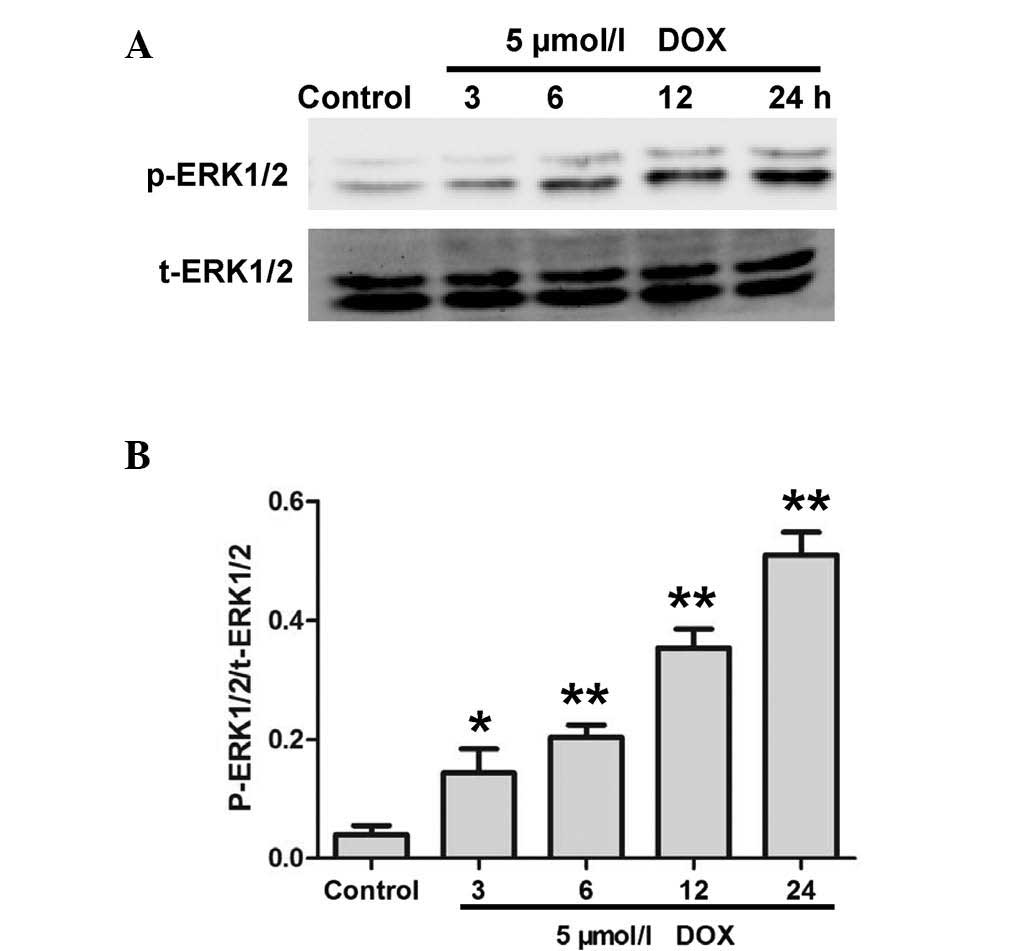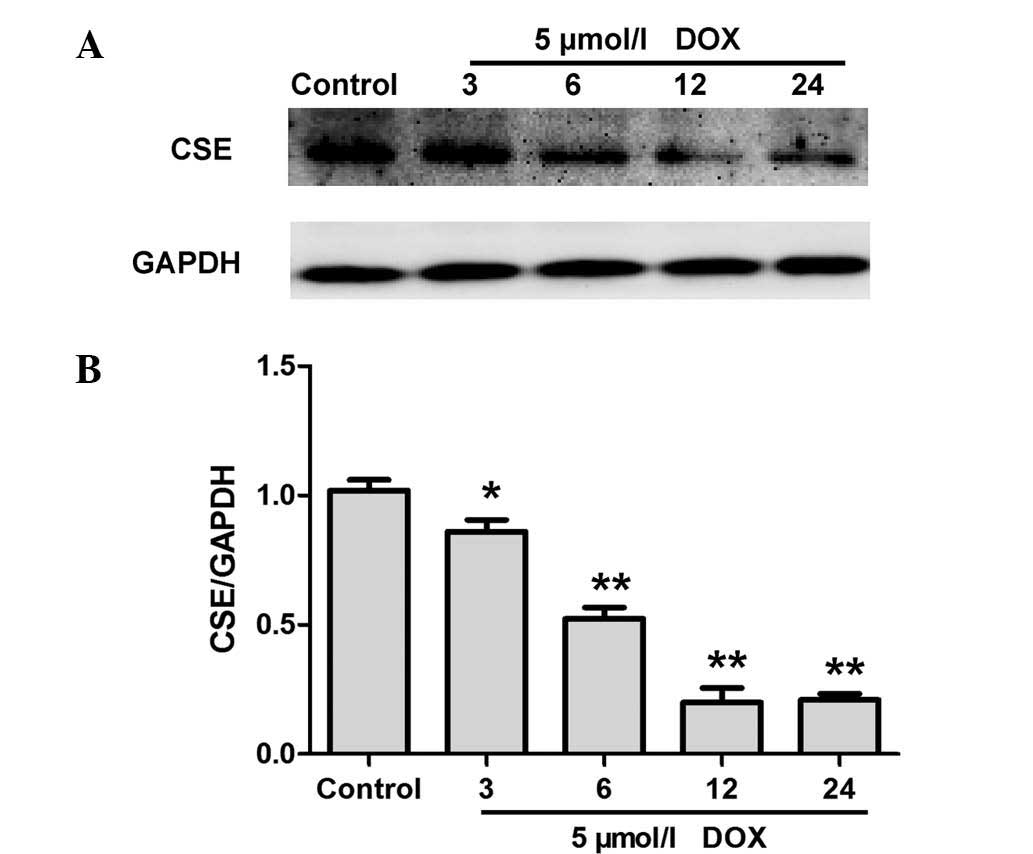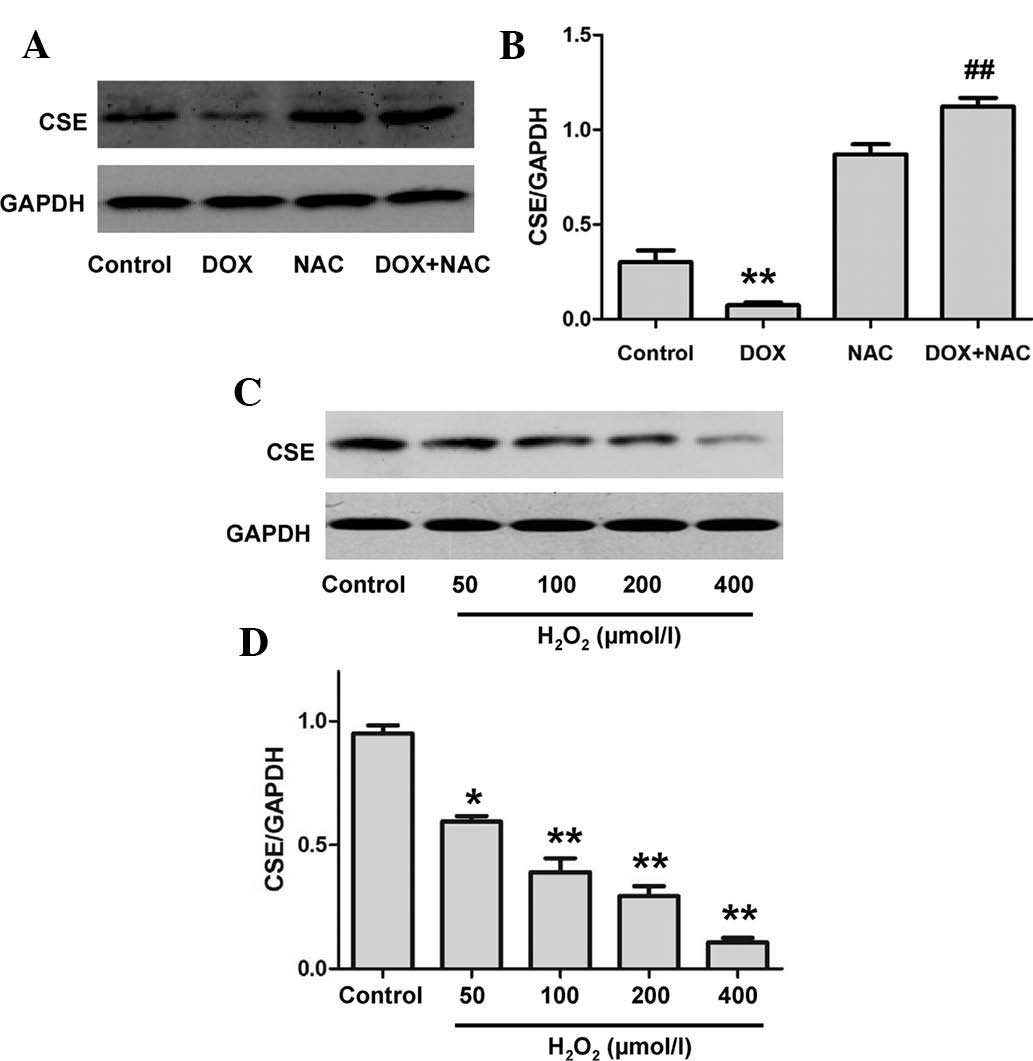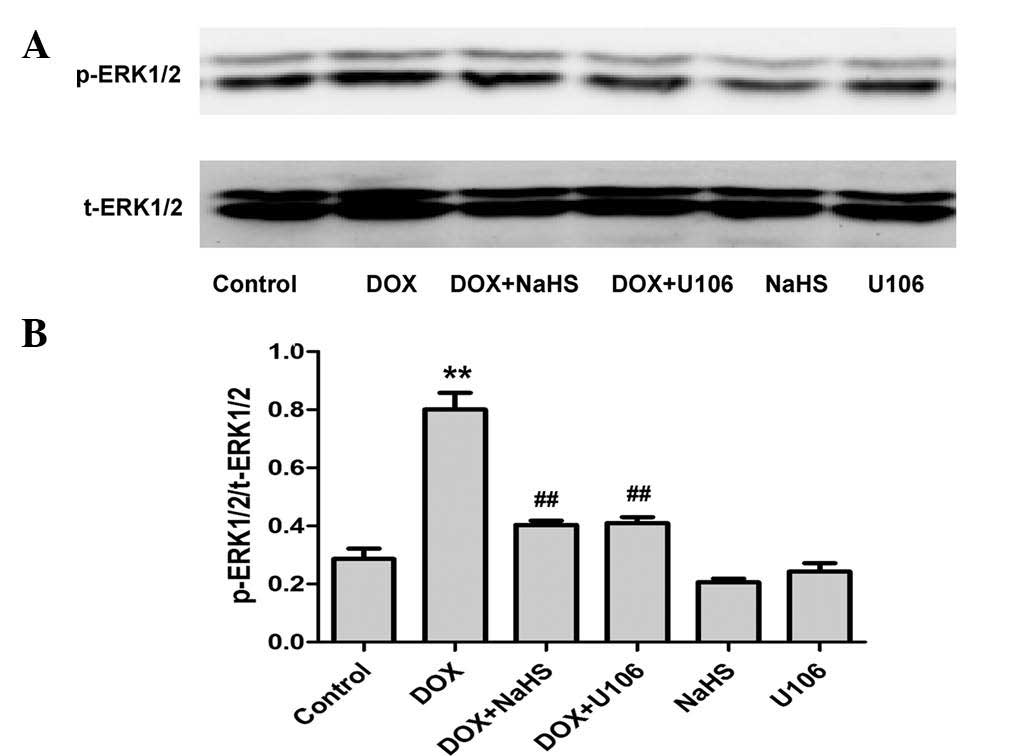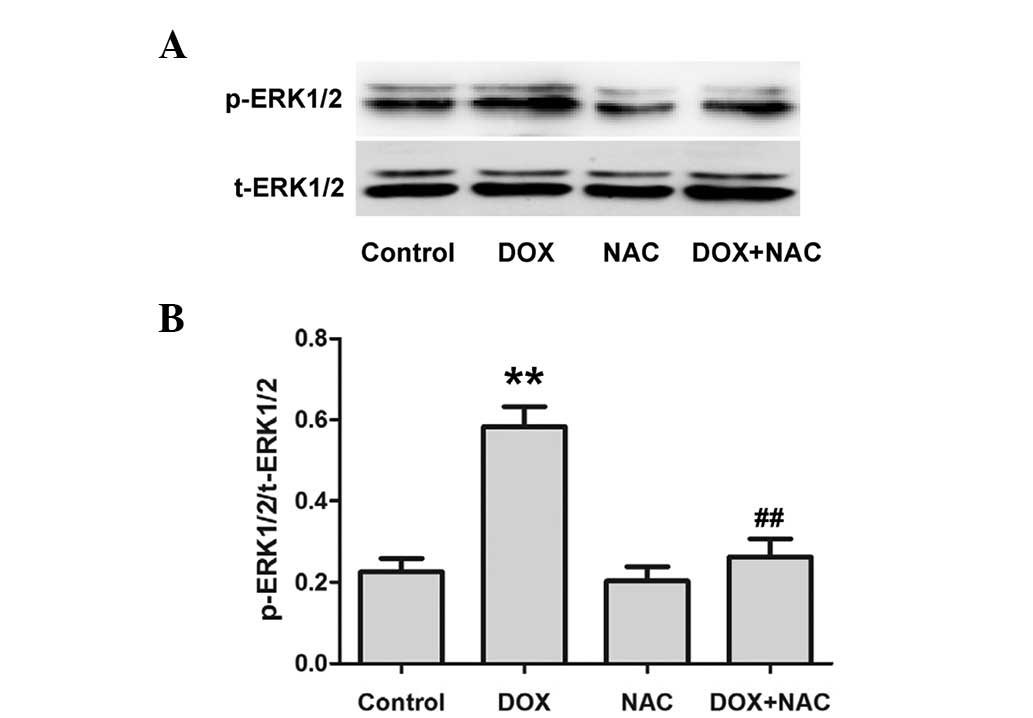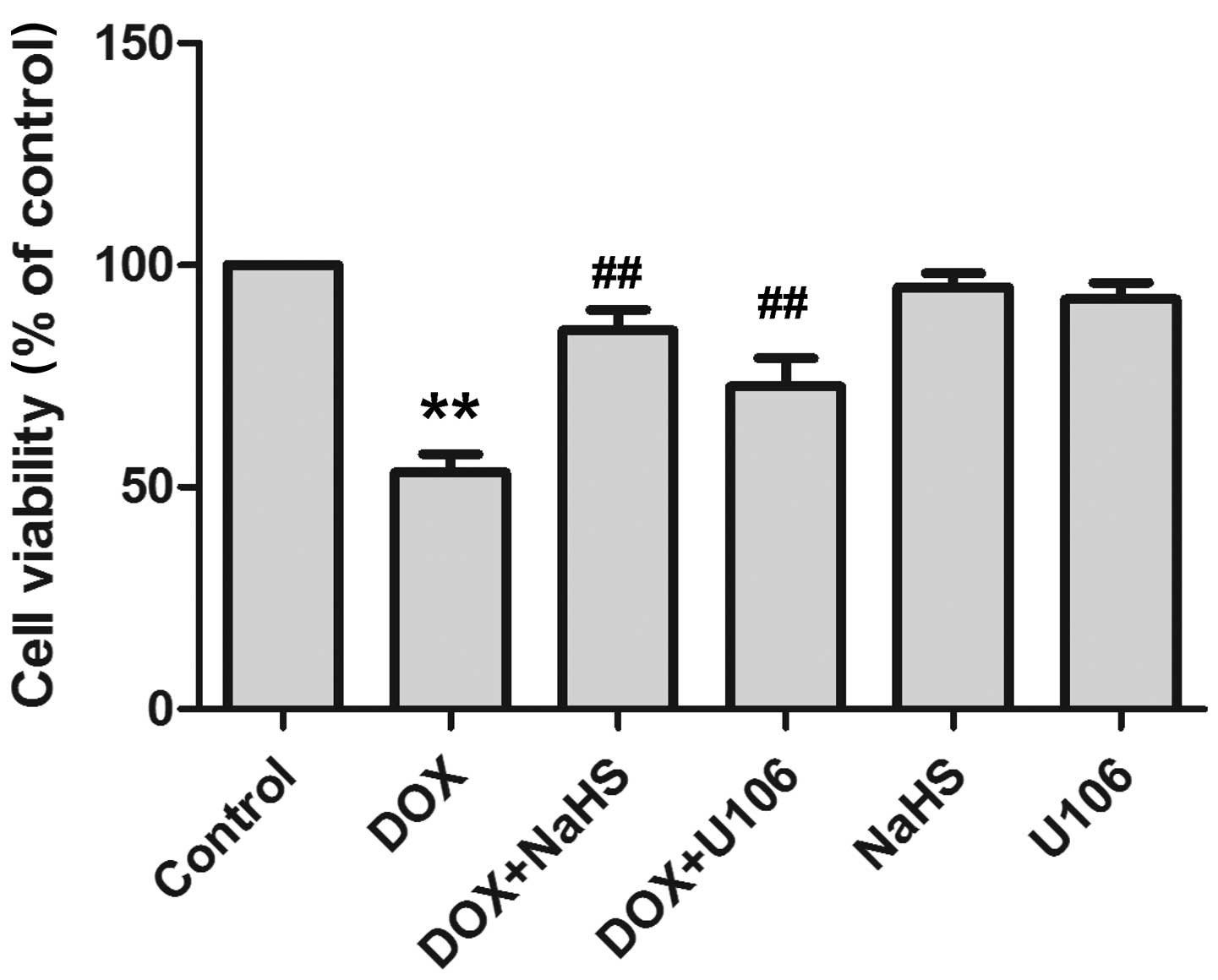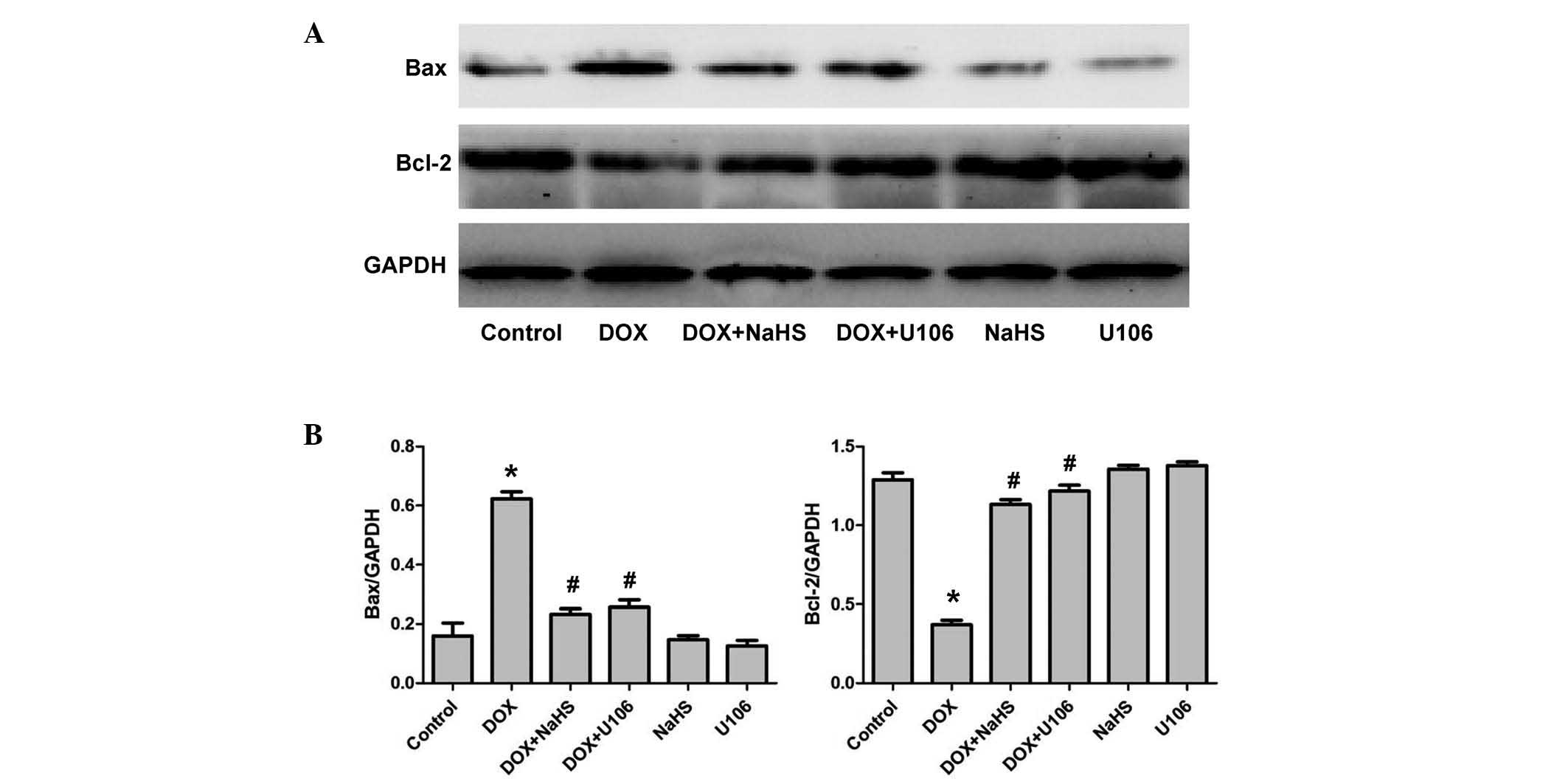Hydrogen sulfide attenuates doxorubicin-induced cardiotoxicity by inhibiting reactive oxygen species-activated extracellular signal-regulated kinase 1/2 in H9c2 cardiac myocytes
- Authors:
- Published online on: August 21, 2015 https://doi.org/10.3892/mmr.2015.4234
- Pages: 6841-6848
Abstract
Introduction
To date, doxorubicin (DOX) remains one of the most widely administered anticancer therapeutic agents, due to its potent therapeutic effects on cancer, including types of leukemia and lymphoma, and breast cancer (1). However, its clinical application is limited due to its marked toxic side-effects on the heart, which may lead to dilated cardiomyopathy and congestive heart failure (2). Numerous studies have implicated reactive oxygen species (ROS) generation in the cardiotoxicity associated with DOX, which ultimately results in cardiomyocyte apoptosis (3,4). However, the signal transduction pathway that links DOX-induced oxidative stress and cardiac injuries remains to be fully elucidated.
Hydrogen sulfide (H2S), a well-known toxic gas, is regarded as the third gasotransmitter, along with nitric oxide and carbon monoxide (5). Increasing evidence indicates that H2S is significant in physiologic and pathophysiological regulation of cardiovascular function (6). Our previous study revealed that increased endogenous H2S generation in the early reperfusion phase is important in ischemia preconditioning (IPC)-elicited protection in isolated hearts (6). Furthermore, previous studies demonstrated that extracellular signal-regulated protein kinase (ERK) 1/2 is activated by oxidative stress and is hypothesized to participate in cardiomyocyte apoptosis, as well as cardiac pathologies (7,8).
Previous studies indicate that ERK1/2 may be involved in DOX-induced cardiomyocyte injury. Lou et al (9) reported that DOX caused an early increase of ERK1/2 phosphorylation in the rat heart, which was followed by the progressive decline of phosphorylated (p)-ERK1/2 to the control three weeks after the final injection of DOX. Liu et al (10) observed that the ERKs/p53 signal transduction pathway is involved in DOX-induced apoptosis in H9c2 cardiac myocytes. In addition, H2S has been demonstrated to exert bidirectional effects on ERK1/2 (11,12). H2S enhances activation of ERK1/2 in mouse pancreatic acinar cells (13); however, it inhibits ERK1/2 activation in INS-1E insulin-secreting β-cell line cells (14). However, whether ROS-activated ERK1/2 is involved in H2S protection against DOX-induced cardiomyocyte injury remains unknown. These previous studies provide a foundation upon which to investigate the role of ROS-activated ERK1/2 in the protective effects of H2S against DOX-induced cardiomyocyte injuries.
Thus, in the current study, H9c2 cardiac myocytes were treated with 5 µM DOX to establish a chemotherapy-induced cardiotoxicity model (15). Whether DOX induces activation of ERK1/2 in H9c2 cardiac myocytes was investigated and the role of ROS-activated ERK1/2 in the protective effect of H2S was elucidated.
Materials and methods
Materials
MTT, Hoechst 33258, 2′,7′-dichlorofluorescein diacetate (DCFH-DA), DOX, U0126, sodium hydrosulfide (NaHS), and N-acetyl-L-cysteine (NAC) and H2O2 were purchased from Sigma-Aldrich (St. Louis, MO, USA). All cell culture medium components were purchased from Thermo Fisher Scientific, Inc. (Waltham, MA, USA) unless otherwise noted. The H9c2 cardiac myocytes were obtained from the Shanghai Cell Library of China (Shanghai, China; http://www.cellbank.org.cn/; originally purchased from the American Type Culture Collection, Manassas, VA, USA).
Cell culture
H9c2 cardiac myocytes (2×107) were cultured in Dulbecco's modified Eagle's medium (DMEM) supplemented with 10% fetal bovine serum (FBS), 100 µg/ml streptomycin (Gibco Life Technologies, Carlsbad, CA, USA) and 100 U/ml penicillin-streptomycin (Gibco Life Technologies) in a humidified 5% CO2 atmosphere at 37°C. H9c2 cardiac myocytes were passaged every two days and seeded at a density of 2×106 cells/dish in 100-mm dishes with 10% calf serum. The cells were incubated for 24 h and the medium changed to 0.5% FBS DMEM for a 24-h starvation. To establish whether the protective effects of H2S were associated with the inhibition of ERK1/2 activity, H9c2 cardiac myocytes were pretreated with 20 µM U0126 (a selective inhibitor of ERK1/2) for 60 min prior to DOX treatment.
MTT assay
The MTT assay was used to assess cell viability. Prior to each experiment, H9c2 cardiac myocytes (5,000 cells/well) were seeded in 96-well microtiter plates. Following incubation with U0126 (20 µM) for 60 min and/or NaHS for 30 min, the cells were treated with 5 µM DOX for a further 24 h. Subsequently, 10 µl MTT solution was added to each well and the microtiter plates were incubated for 4 h at 37°C. The absorbance was measured at 470 nm using a SpectraMax 190 spectrophotometer (Molecular Devices LLC, Sunnyvale, CA, USA) and applied to calculate the relative ratio of cell viability. Three independent experiments were performed for each experimental condition.
Assessment of H9c2 cardiac myocyte apoptosis
Apoptosis was analyzed by fluorescence microscopy using Hoechst 33258, a chromatin dye. H9c2 cardiac myocytes were incubated in DMEM containing 0.5% FBS for 24 h (control group), 50 mM DOX for 24 h (DOX group), 100 µM NaHS for 30 min prior to exposure to 5 µM DOX for 24 h (NaHS + DOX group), 20 µM U0126 for 60 min followed by exposure to 5 µM DOX for 24 h (U0126 + DOX group), treated with 100 µM NaHS for 30 min followed by a 24-h culture (NaHS group), and treated with 20 µM U0126 for 60 min followed by a 24-h culture (U0126 group). Following various treatments, the cells were fixed in ice-cold 4% paraformaldehyde (Sigma-Aldrich) dissolved in phosphate-buffered saline (PBS) at room temperature for 20 min. Nonspecific binding was blocked using 5% normal goat serum (Sigma-Aldrich) in 0.01 M PBS containing 0.3% Triton X-100. Cells were washed twice with PBS and incubated for 15 min with 10 µg/ml Hoechst 33258 at room temperature in the dark. The cells were visualized under a fluorescence microscope (BX50-FLA; Olympus Corporation, Tokyo, Japan). Condensed, fractured or distorted nuclei indicated apoptotic cells, whereas normal nuclear size and uniform fluorescence were indicative of viable cells.
Measurement of intracellular ROS levels
The determination of intracellular ROS levels was performed by measuring a fluorescent product, which was formed by the oxidation of DCFH-DA. Briefly, the culture medium was removed and the cells were washed three times with PBS. Following the addition of fresh culture medium, the cells were incubated at 37°C for 30 min with DCFH-DA at a final concentration of 10 µmol/l. The cells were washed three further times with PBS and the relative quantity of fluorescent product was assessed using the fluorescence microscope connected to an imaging system. The mean fluorescence intensity (MFI) from five random fields was measured using ImageJ 1.41o software (National Institutes of Health, Bethesda, MD, USA) and the MFI served as an index of the ROS quantity. The experiment was performed in triplicate.
Western blot analysis
The cells were homogenized directly into 10X cell lysis buffer (Cell Signaling Technology, Inc., Danvers, MA, USA) and Phosphatase Inhibitor Cocktail (Sigma-Aldrich), lysates were centrifuged at 12,000 ×g for 10 min at 4°C. The protein concentration was determined using a BCA protein assay kit (Beyotime Institute of Biotechnology, Haimen, China) according to the manufacturer's instruction. The extracted proteins were combined with 5% SDS-PAGE sample buffer (Beyotime Institute of Biotechnology), boiled at 100°C for 7 min and separated by 10% SDS-PAGE. Following electrophoresis, the proteins were transferred to polyvinylidene difluoride membranes. The membranes were blocked in Tris-buffered saline and Tween-20 (TBS-T; 0.1% Tween-20) containing 5% non-fat dry milk for 2 h at room temperature with rotation. Subsequent to blocking, the membranes were incubated with the following antibodies (all obtained from Cell Signaling Technology, Inc.) at 4°C overnight: Rabbit anti-ERK1/2 polyclonal antibody (cat no. 4695P; dilution, 1:2,000), rabbit anti-p-ERK1/2 monoclonal antibody (cat no. 4370P; dilution, 1:2,000) (Cell Signaling Technology, Inc.), rabbit anti-cystathionine γ-lyase (CSE) polyclonal antibody (cat no. 12217-1-AP 1:1,000; Proteintech, Chicago, IL, USA), GAPDH (cat no. AG019; Beyotime Institute of Biotechnology, Shanghai, China) rabbit anti-Bax polyclonal antibody (cat no. 2772T; dilution, 1:1,000), and rabbit anti-Bcl-2 polyclonal antibody (cat no. 2870T; dilution, 1:1,000) (Cell Signaling Technology, Inc.). The membranes were incubated in 5% milk or bovine serum albumin (Beyotime Institute of Biotechnology) overnight at 4°C. The membranes were washed three times in TBS-T to remove the primary antibody, and incubated for 2 h with horseradish peroxidase-labeled goat anti-rabbit immunoglobulin G (1:1,000, Beyotime Institute of Biotechnology; cat no. A0208). Following three washes in TBS-T, the antigen-antibody bands were detected using an enhanced chemiluminescence reagent kit (Beyotime Institute of Biotechnology) and quantified using Quantity One densitometry software, version 4.6.2 (Bio-Rad Laboratories, Inc., Hercules, CA, USA). The western blot data of p-ERK1/2 were presented as a ratio of the phosphorylated forms to their total forms.
Statistical analysis
Results are presented as means ± standard error of the mean. Statistical analysis was performed using Student's t-test or one-way analysis of variance with SPSS 13.0 (SPSS, Inc., Chicago, IL, USA). P<0.05 was considered to indicate a statistically significant difference.
Results
DOX upregulates the expression of p-ERK1/2 in H9c2 cardiac myocytes
H9c2 cardiac myocytes were treated with DOX for 0, 3, 6, 12 and 24 h to investigate whether DOX treatment exerted an effect on p-ERK1/2 expression. Western blot analysis revealed that treatment of H9c2 cardiac myocytes with DOX significantly upregulated the expression of p-ERK1/2 in a time-dependent manner (Fig. 1).
DOX inhibits CSE expression in H9c2 cardiac myocytes
CSE is a major enzyme responsible for endogenous H2S generation in H9c2 cardiac myocytes (16). Western blot analysis was performed to evaluate whether DOX decreases endogenous H2S production by inhibiting the expression of CSE. As shown in Fig. 2, treatment with DOX for 0, 3, 6, 12 and 24 h resulted in a significant downregulation of CSE expression in H9c2 cardiac myocytes. These data indicate that DOX inhibited CSE expression levels in H9c2 cardiac myocytes, and therefore contributed to a DOX-elicited decrease in endogenous H2S production.
Oxidative stress contributes to DOX-induced inhibition of CSE expression in H9c2 cardiac myocytes
Oxidative stress is a primary mechanism by which DOX induces cardiomyocyte injury. To establish whether oxidative stress participates in the inhibition of CSE expression caused by DOX treatment, H9c2 cardiac myocytes were preconditioned with the ROS scavenger, NAC (1,000 µM) for 60 min prior to DOX treatment. The results demonstrate that pretreatment of H9c2 cardiac myocytes with NAC significantly attenuated DOX-induced downregulation of CSE expression (Fig. 3A and B). In addition, comparable with the role of DOX, hydrogen peroxide (an exogenous ROS) was observed to suppress CSE expression (Fig. 3C and D). These data suggest that oxidative stress contributes to DOX-induced downregulation of CSE expression in H9c2 cardiac myocytes.
Exogenous H2S inhibits DOX-induced expression of p-ERK1/2 in H9c2 cardiac myocytes
In order to determine the effect of H2S on DOX-induced activation of ERK1/2, H9c2 cardiac myocytes were pretreated with NaHS (a donor of H2S) prior to exposure to DOX. As demonstrated in Fig. 4, pretreatment with NaHS significantly attenuated DOX-induced overexpression of p-ERK1/2. In addition, to further elucidate the role of ERK1/2 in the cardioprotective action of H2S, the effect of U0126, a specific ERK1/2 inhibitor, on DOX-induced expression of p-ERK1/2 was investigated. As shown in Fig. 4, consistent with the effects of NaHS, pretreatment with 20 µM U0126 for 60 min significantly attenuated the DOX-induced overexpression of p-ERK1/2. NaHS or U0126 alone did not exert an effect on the expression of total (t)-ERK1/2. These data indicate that the cardioprotective action of H2S is associated with its inhibitory effect on DOX-induced ERK1/2 activation.
NAC suppresses the DOX-induced expression of p-ERK1/2 in H9c2 cardiac myocytes
To identify whether the inhibitory effect of NaHS on the DOX-induced expression of p-ERK1/2 is associated with its antioxidation, H9c2 cardiac myocytes were pretreated with NAC (a ROS scavenger) prior to DOX exposure. As shown in Fig. 5, the pretreatment of cells with NAC significantly attenuated the expression of p-ERK1/2, which is consistent with the inhibitory effect of NaHS and U0126 pretreatment; however, NAC alone did not significantly alter the expression levels of t-ERK1/2. These results reveal that an antioxidant effect may have contributed to the inhibitory effect of H2S on the DOX-induced expression of p-ERK1/2.
Inhibition of ERK1/2 activation contributed to protection of H2S against DOX-induced cytotoxicity
As presented in Fig. 6, exposure of H9c2 cardiac myocytes to DOX resulted in marked cytotoxicity, leading to a decrease in cell viability. However, pretreatment of cells with NaHS significantly ameliorated the DOX-induced cytotoxicity, which was evidenced by an increase in cell viability. To assess whether the activation of ERK1/2 is involved in DOX-induced cytotoxicity, H9c2 cardiac myocytes were pretreated with U0126, a selective inhibitor of ERK1/2. The results demonstrate that pretreatment with U0126 exerts a similar cytoprotective effect to H2S against DOX-induced cytotoxicity. NaHS or U0126 treatment alone was not observed to alter cell viability in the H9c2 cardiac myocytes. The findings indicate that H2S blocks DOX-induced cytotoxicity in H9c2 cardiac myocytes, partially by inhibiting the activation of ERK1/2.
Inhibition of ERK1/2 activation contributes to the protective effect of H2S against DOX-induced apoptosis
The effects of NaHS and ERK1/2 inhibition on DOX-induced apoptosis were investigated further. As shown in Fig. 7A, H9c2 cardiac myocytes treated with DOX exhibited typical characteristics of apoptosis, including condensation of chromatin, shrinkage of nuclei and apoptotic bodies. However, pretreatment of cells with NaHS markedly decreased the DOX-induced increased number of cells exhibiting nuclear condensation and fragmentation. To ascertain whether the activation of ERK1/2 is implicated in DOX-induced cardiotoxicity, H9c2 cardiac myocytes were pretreated with U0126. The results revealed that pretreatment with U0126 attenuated the DOX-induced increased number of apoptotic H9c2 cardiac myocytes (Fig. 7B). Treatment with NaHS or U0126 alone did not markedly alter H9c2 cell morphology or the percentage of apoptotic H9c2 cardiac myocytes. These findings demonstrate that the ERK1/2 signaling pathway participates in DOX-induced cardiotoxicity.
Exogenous H2S and the ERK1/2 inhibitor, U0126, reduce DOX-induced oxidative stress in H9c2 cardiac myocytes
Previous studies have shown that oxidative stress is critical in DOX-induced cardiotoxicity. Thus, the effects of H2S and U0126 on DOX-induced ROS generation in H9c2 cardiac myocytes were investigated in the present study. As shown in Fig. 8, exposure of cells to 5 µM DOX for 24 h significantly enhanced ROS generation. However, the increased ROS generation was attenuated by pretreatment with NaHS, indicating that exogenous H2S protects H9c2 cardiac myocytes against DOX-induced oxidative stress. To investigate whether the activation of ERK1/2 contributes to the DOX-induced overproduction of ROS, H9c2 cardiac myocytes were preconditioned with U0126. The results revealed that preconditioning with U0126 significantly decreased the DOX-induced increase in ROS generation. Treatment with NaHS or U0126 alone, however, did not alter basal ROS generation. The results suggest that antioxidation of H2S is partly associated with inhibition of ERK1/2 activation in H9c2 cardiac myocytes.
Exogenous H2S and ERK1/2 inhibitor, U0126, inhibit DOX-induced cytotoxicity via upregulation of Bcl-2 protein expression and downregulation of Bax protein expression
Bcl-2 is an anti-apoptotic protein and Bax is a pro-apoptotic protein. To elucidate whether H2S modulates the expression of Bcl-2 and Bax in DOX-stimulated H9c2 cardiac myocytes, the expression levels of Bcl-2 and Bax protein were investigated. As presented in Fig. 9, DOX markedly decreased the level of Bcl-2 expression and increased the level of Bax expression. However, pretreatment with NaHS or U0126 prior to administration of DOX, demonstrated that the protein expression levels of Bax were decreased, whereas the Bcl-2 protein expression levels increased. These results indicate that H2S prevents apoptosis in H9c2 cardiac myocytes by upregulating Bcl-2 protein expression and inhibiting Bax protein expression.
Discussion
Numerous studies have shown that the major molecular mechanism involved in DOX-induced cardiotoxicity is free radical-induced oxidative stress and cardiac myocyte death by apoptosis and necrosis. Concordant with previous studies (17,18), in the present study, it was observed that exposure of H9c2 cardiac myocytes to DOX markedly induced cellular injuries, including a decrease in cell viability, increased cell apoptosis, ROS generation and activation of ERK1/2.
Previously, the cardioprotective effects of H2S have been demonstrated in animal models of disease (19,20). H2S infusion significantly reduced myocardial infarct size and improved regional left ventricular function, as well as endothelium-dependent and -independent micro-vascular reactivity in a porcine model of myocardial ischemia-reperfusion (I/R) (21). In addition, H2S has been shown to attenuate myocardial necrosis and apoptosis (22). Endogenous H2S has been associated with cardioprotection in rat ventricular myocytes as a result of metabolic inhibition preconditioning (23). Furthermore, inhibition of endogenous H2S generation by inhibition of its synthesis inhibitor has been shown to block the protective effect of IPC in isolated hearts, as well as isolated cardiac myocytes (24). In the present study, H9c2 cardiac myocytes were used to investigate the effect of DOX on endogenous H2S generation and its role in the cardiotoxicity of DOX. Exposure of H9c2 cardiac myocytes to DOX was observed to result in a significant decrease in H2S generation.
ERK1/2 is important in cell proliferation, growth and cell death (25). Previous research indicates that the ERK1/2 signaling pathway is activated by DOX-induced apoptosis in H9c2 cardiac myocytes (26). Furthermore, ERK activation has been demonstrated to be important in certain models that induce apoptosis in the myocardium, including isoproterenol-induced apoptosis (27) and I/R in neonatal cardiomyocytes that induce apoptosis (28). In the current study, the results showed that the expression level of p-ERK1/2 was increased following DOX-induced injury in H9c2 cardiac myocytes, and H2S treatment decreased the expression level of p-ERK1/2, and subsequently inhibited DOX-induced injuries in H9c2 cardiac myocytes. Additionally, the present study further demonstrated that the ERK1/2 inhibitor, U0126 markedly reduced DOX-induced injuries (which was evidenced by an increase in cell viability), decreased the expression level of p-ERK1/2, and attenuated DOX-induced apoptosis in H9c2 cardiac myocytes. These results indicate that inhibition of the ERK1/2 signaling pathway may be involved in the protection of exogenous H2S.
Notably, the present study further demonstrated that ROS were involved in DOX-induced cell injuries and whether DOX activation of ERK1/2 is due to its induction of ROS was investigated. It was shown that pretreatment of H9c2 cardiac myocytes with NAC (a ROS scavenger) significantly attenuated DOX-induced expression of p-ERK1/2. Collectively, the results of the present study support the hypothesis that DOX induction of ROS activates ERK1/2, which mediates DOX-induced injuries in H9c2 cardiac myocytes.
The effect of H2S on regulating the intracellular Bcl-2/Bax signaling pathway was investigated in the present study to provide further biochemical evidence elucidating the protective effect of H2S on cardiac myocytes against DOX-induced injuries. Bcl-2 is an oncogene-derived protein, which confers negative control in the signaling pathway of cellular suicide machinery (29). Bax is a Bcl-2 homologous protein, which promotes cell death by competing with Bcl-2 (30). Compared with the controls, DOX exposure was observed to downregulate the protein expression of Bcl-2, while it increased Bax protein expression in H9c2 cardiac myocytes. Furthermore, H2S supplementation in H9c2 cardiac myocytes significantly reduced DOX-induced Bax expression and augmented DOX-suppressed Bcl-2 expression, and these effects were associated with a decrease in apoptotic levels. The results suggested a potent protective effect by H2S against DOX-induced injuries, partly through upregulation of Bcl-2 and downregulation of Bax.
In conclusion, the principal finding of the current study was that H2S inhibits DOX-induced cardiotoxicity in H9c2 cardiac myocytes, and its effects may involve inhibition of ROS-mediated activation of ERK1/2, upregulation of Bcl-2 and downregulation of Bax. The present study elucidated the underlying mechanisms of H2S protection against DOX-induced cardiotoxicity, and provided valuable evidence for identifying H2S as a novel therapeutic strategy for the treatment and prevention of DOX-induced cardiomyopathy.
Acknowledgments
The present study was supported by grants provided by the Medical Scientific Research Fund of Guangdong Province (grant no. A2014810) and the Graduate Student Research Innovation Project of Hunan Province (grant no. CX2013B397).
References
|
Menna P, Recalcati S, Cairo G and Minotti G: An introduction to the metabolic determinants of anthracycline cardiotoxicity. Cardiovasc Toxicol. 7:80–85. 2007. View Article : Google Scholar : PubMed/NCBI | |
|
Lipshultz SE, Karnik R, Sambatakos P, Franco VI, Ross SW and Miller TL: Anthracycline-related cardiotoxicity in childhood cancer survivors. Curr Opin Cardiol. 29:103–112. 2014. View Article : Google Scholar | |
|
Spallarossa P, Garibaldi S, Altieri P, Fabbi P, Manca V, Nasti S, Rossettin P, Ghigliotti G, Ballestrero A, Patrone F, et al: Carvedilol prevents doxorubicin-induced free radical release and apoptosis in cardiomyocytes in vitro. J Mol Cell Cardiol. 37:837–846. 2004. View Article : Google Scholar : PubMed/NCBI | |
|
Liu MH, Zhang Y, Lin XL, He J, Tan TP, Wu SJ, Yu S, Chen L, Chen YD, Fu HY, et al: Hydrogen sulfide attenuates doxorubicin-induced cardiotoxicity through inhibiting calreticulin expression in H9c2 cells. Mol Med Rep. Jul 2–2015.Epub ahead of print. View Article : Google Scholar | |
|
Zhang Y, Tang ZH, Ren Z, Qu SL, Liu MH, Liu LS and Jiang ZS: Hydrogen sulfide, the next potent preventive and therapeutic agent in aging and age-associated diseases. Mol Cell Biol. 33:1104–1113. 2013. View Article : Google Scholar : PubMed/NCBI | |
|
Huang YE, Tang ZH, Xie W, Shen XT, Liu MH, Peng XP, Zhao ZZ, Nie DB, Liu LS and Jiang ZS: Endogenous hydrogen sulfide mediates the cardioprotection induced by ischemic post-conditioning in the early reperfusion phase. Exp Ther Med. 4:1117–1123. 2012.PubMed/NCBI | |
|
Grisanti LA, Talarico JA, Carter RL, Yu JE, Repas AA, Radcliffe SW, Tang HA, Makarewich CA, Houser SR and Tilley DG: β-Adrenergic receptor-mediated transactivation of epidermal growth factor receptor decreases cardiomyocyte apoptosis through differential subcellular activation of ERK1/2 and Akt. J Mol Cell Cardiol. 72:39–51. 2014. View Article : Google Scholar : PubMed/NCBI | |
|
Xu W, Wu W, Chen J, Guo R, Lin J, Liao X and Feng J: Exogenous hydrogen sulfide protects H9c2 cardiac cells against high glucose-induced injury by inhibiting the activities of the p38 MAPK and ERK1/2 pathways. Int J Mol Med. 32:917–925. 2013.PubMed/NCBI | |
|
Lou H, Danelisen I and Singal PK: Involvement of mitogen-activated protein kinases in adriamycin-induced cardiomyopathy. Am J Physiol Heart Circ Physiol. 288:H1925–H1930. 2005. View Article : Google Scholar : PubMed/NCBI | |
|
Liu J, Mao W, Ding B and Liang CS: ERKs/p53 signal transduction pathway is involved in doxorubicin induced apoptosis in H9c2 cells and cardiomyocytes. Am J Physiol Heart Circ Physiol. 295:H1956–H1965. 2008. View Article : Google Scholar : PubMed/NCBI | |
|
Du J, Hui Y, Cheung Y, Bin G, Jiang H, Chen X and Tang C: The possible role of hydrogen sulfide as a smooth muscle cell proliferation inhibitor in rat cultured cells. Heart Vessels. 19:75–80. 2004. View Article : Google Scholar : PubMed/NCBI | |
|
Oh GS, Pae HO, Lee BS, Kim BN, Kim JM, Kim HR, Jeon SB, Jeon WK, Chae HJ and Chung HT: Hydrogen sulfide inhibits nitric oxide production and nuclear factor-kappaB via heme oxygenase-1 expression in RAW264.7 macrophages stimulated with lipopolysaccharide. Free Radic Biol Med. 41:106–119. 2006. View Article : Google Scholar : PubMed/NCBI | |
|
Adhikari S and Bhatia M: H2S-induced pancreatic acinar cell apoptosis is mediated via JNK and p38 MAP kinase. J Cell Mol Med. 12:1374–1383. 2008. View Article : Google Scholar : PubMed/NCBI | |
|
Yang G, Yang W, Wu L and Wang R: H2S, endoplasmic reticulum stress and apoptosis of insulin-secreting beta cells. J Biol Chem. 282:16567–16576. 2007. View Article : Google Scholar : PubMed/NCBI | |
|
Guo R, Lin J, Xu W, Shen N, Mo L, Zhang C and Feng J: Hydrogen sulfide attenuates doxorubicin-induced cardiotoxicity by inhibition of the p38 MAPK pathway in H9c2 cells. Int J Mol Med. 31:644–650. 2013.PubMed/NCBI | |
|
Kimura H: Hydrogen sulfide: Its production, release and functions. Amino Acids. 41:113–121. 2011. View Article : Google Scholar | |
|
Wang X, Wang XL, Chen HL, Wu D, Chen JX, Wang XX, Li RL, He JH, Mo L, Cen X, et al: Ghrelin inhibits doxorubicin cardio-toxicity by inhibiting excessive autophagy through AMPK and p38-MAPK. Biochem Pharmacol. 88:334–350. 2014. View Article : Google Scholar : PubMed/NCBI | |
|
Guo R, Wu K, Chen J, Mo L, Hua X, Zheng D, Chen P, Chen G, Xu W and Feng J: Exogenous hydrogen sulfide protects against doxorubicin-induced inflammation and cytotoxicity by inhibiting p38MAPK/NFkappaB pathway in H9c2 cardiac cells. Cell Physiol Biochem. 32:1668–1680. 2013. | |
|
Łowicka E and Bełtowski J: Hydrogen sulfide (H2S)-the third gas of interest for pharmacologists. Pharmacol Rep. 59:4–24. 2007. | |
|
Ji Y, Pang QF, Xu G, Wang L, Wang JK and Zeng YM: Exogenous hydrogen sulfide postconditioning protects isolated rat hearts against ischemia-reperfusion injury. Eur J Pharmacol. 587:1–7. 2008. View Article : Google Scholar : PubMed/NCBI | |
|
Osipov RM, Robich MP, Feng J, Liu Y, Clements RT, Glazer HP, Sodha NR, Szabo C, Bianchi C and Sellke FW: Effect of hydrogen sulfide in a porcine model of myocardial ischemia-reperfusion: comparison of different administration regimens and characterization of the cellular mechanisms of protection. J Cardiovasc Pharmacol. 54:287–297. 2009. View Article : Google Scholar : PubMed/NCBI | |
|
Sodha NR, Clements RT, Feng J, Liu Y, Bianchi C, Horvath EM, Szabo C and Sellke FW: The effects of therapeutic sulfide on myocardial apoptosis in response to ischemia-reperfusion injury. Eur J Cardiothorac Surg. 33:906–913. 2008. View Article : Google Scholar : PubMed/NCBI | |
|
Pan TT, Feng ZN, Lee SW, Moore PK and Bian JS: Endogenous hydrogen sulfide contributes to the cardioprotection by metabolic inhibition preconditioning in the rat ventricular myocytes. J Mol Cell Cardiol. 40:119–130. 2006. View Article : Google Scholar | |
|
Bian JS, Yong QC, Pan TT, Feng ZN, Ali MY, Zhou S and Moore PK: Role of hydrogen sulfide in the cardioprotection caused by ischemic preconditioning in the rat heart and cardiac myocytes. J Pharmacol Exp Ther. 316:670–678. 2006. View Article : Google Scholar | |
|
Javadov S, Jang S and Agostini B: Crosstalk between mitogenactivated protein kinases and mitochondria in cardiac diseases: Therapeutic perspectives. Pharmacol Ther. 144:202–225. 2014. View Article : Google Scholar : PubMed/NCBI | |
|
Liu J, Mao W, Ding B and Liang CS: ERKs/p53 signal transduction pathway is involved in doxorubicin-induced apoptosis in H9c2 cells and cardiomyocytes. Am J Physiol Heart Circ Physiol. 295:H1956–H1965. 2008. View Article : Google Scholar : PubMed/NCBI | |
|
Zhou B, Wu LJ, Tashiro S, Onodera S, Uchiumi F and Ikejima T: Activation of extracellular signal-regulated kinase during silibinin-protected, isoproterenol-induced apoptosis in rat cardiac myocytes is tyrosine kinase pathway-mediated and protein kinase C-dependent. Acta Pharmacol Sin. 28:803–810. 2007. View Article : Google Scholar : PubMed/NCBI | |
|
Jiang CM, Han LP, Li HZ, Qu YB, Zhang ZR, Wang R, Xu CQ and Li WM: Calcium-sensing receptors induce apoptosis in cultured neonatal rat ventricular cardiomyocytes during simulated ischemia/reperfusion. Cell Biol Int. 32:792–800. 2008. View Article : Google Scholar : PubMed/NCBI | |
|
Gómez-Fernández JC: Functions of the C-terminal domains of apoptosis-related proteins of the Bcl-2 family. Chem Phys Lipids. 183:77–90. 2014. View Article : Google Scholar : PubMed/NCBI | |
|
Renault TT and Manon S: Bax: Addressed to kill. Biochimie. 93:1379–1391. 2011. View Article : Google Scholar : PubMed/NCBI |



